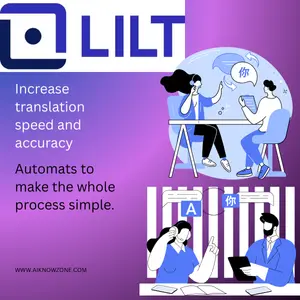Glide AI
Glide AI lets you build mobile apps from spreadsheets, no coding needed! Simple, fast, and affordable. Read my full review!
Description
Introduction
So, I recently decided to dive headfirst into the world of Glide AI, and let me tell you, it’s been a wild ride! 🚀 Glide AI isn’t just another AI tool; it’s a platform that lets you build mobile apps from spreadsheets. Yes, you read that right – spreadsheets! It’s unique because it completely bypasses the need for traditional coding and complex app development processes. Instead, you leverage the power of Google Sheets (or even Airtable) to create functional, visually appealing apps. I was initially skeptical, but the sheer simplicity and potential quickly won me over. I’m still figuring things out, but so far, my experience has been remarkably positive.
Key Features & Benefits ✨
- No-code app building: This is Glide’s biggest selling point. You don’t need to know a single line of code to build a functional app. This opens up app development to a much wider audience, empowering individuals and small businesses to create their own tools without needing expensive developers. It’s incredibly democratizing!
- Seamless Google Sheets integration: Glide works beautifully with Google Sheets, importing data effortlessly. This means if you already use spreadsheets for data management, transitioning to Glide is smooth and intuitive. Plus, it enables dynamic updates; whenever you update your spreadsheet, your app automatically reflects those changes – magical! ✨
- Customizable templates and components: Glide offers a range of templates to get you started quickly. Furthermore, you can personalize the look and feel of your app by choosing from various pre-designed components or even creating your own. This allows for a surprisingly high level of customization, even without coding.
- User-friendly interface: Navigating Glide’s interface is intuitive and easy. Even for someone with minimal tech experience, the drag-and-drop functionality and clear instructions make app building straightforward and enjoyable. The learning curve is incredibly gentle!
- Offline functionality (with limitations): While not fully offline, Glide apps offer some functionality offline, which is a great plus for those who need to access their apps without a constant internet connection. However, bear in mind that certain features and data syncing might require online access.
How It Works (Simplified) 🤓
Essentially, you start with your data in a Google Sheet (or Airtable). Then, you connect that spreadsheet to Glide. Glide’s interface lets you visually design the app’s layout, selecting components like lists, forms, maps, and more. You drag and drop elements onto the canvas, connecting them to your spreadsheet data. Then, you customize the appearance – colors, fonts, images – until you’re happy with the result. Finally, you publish your app and share it with others. The whole process is surprisingly simple, even intuitive. I found the process quite similar to using a powerful design tool but with an app-building focus. It feels empowering to build something substantial with such ease!
Real-World Use Cases For Glide AI
- Last month, I was helping a local artist manage their inventory and client orders. Instead of cumbersome spreadsheets, we used Glide to build a simple app where they could easily update stock, track sales, and manage client information. It was a game-changer – so much more efficient!
- A few weeks ago, I needed a quick way to collect feedback on a new product concept. I created a Glide app with a simple form, and within hours, I had dozens of responses. Glide completely streamlined the feedback collection process and made it incredibly easy to analyze the data.
- Just recently, a friend needed a mobile app to track their fitness goals. Using a simple spreadsheet and Glide, we crafted a personal fitness tracker app where he could monitor workouts, progress, and set targets. It was completed in just a couple of hours – unbelievably simple and powerful!
Pros of Glide AI 👍
- Ease of use: The no-code approach makes Glide remarkably easy to learn and use.
- Speed of development: Building apps is significantly faster compared to traditional methods.
- Cost-effectiveness: Glide offers affordable plans, making it accessible to individuals and businesses.
- Great for prototyping: Glide is perfect for creating and testing app ideas before investing in complex development.
- User-friendly interface: The interface is intuitive and enjoyable to work with. Even if you’re not a tech whiz, you can quickly build impressive apps.
Cons of using Glide 👎
- Limited functionality: Compared to native apps, Glide apps may lack certain features or advanced functionalities.
- Dependence on internet connectivity: Some features rely heavily on internet access for optimal performance. But still has offline features, this still is a big win.
- Potential performance issues: Large datasets might impact app performance or cause slow loading times.
- Pricing: While affordable, the paid plans can become more expensive as your usage increases. But it’s far cheaper than hiring a developer.
Glide AI Pricing 💰
Glide offers a free plan with limitations, and various paid plans with increasing features and usage limits. Pricing varies depending on the plan and features you need. Check Glide’s website for the most up-to-date pricing information.
Conclusion 🏁
Overall, Glide AI is a fantastic tool for anyone looking to build mobile apps without coding. It’s intuitive, fast, and cost-effective. While it might not be suitable for complex, feature-rich apps, it’s perfect for prototyping, creating simple applications, and quickly launching MVPs. If you’re a non-technical user, a small business owner, or simply someone who wants to build apps without learning to code, then Glide AI is definitely worth checking out. I highly recommend it!





Reviews
There are no reviews yet.